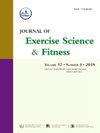Effects of 8 weeks of rhythmic physical activity on gross motor movements in 4-5-year-olds: A randomized controlled trial
IF 2.4
2区 医学
Q2 SPORT SCIENCES
引用次数: 0
Abstract
Objective
Rhythmic physical activity holds promise for positively influencing the gross motor development of 4-5-year-old children, yet empirical research in this domain remains limited. This study aimed to investigate the effects of rhythmic physical activity on the gross motor development in children aged 4–5 years.
Methods
Fifty children aged 4–5 years were recruited and randomly assigned to either the intervention or control group. Both groups participated in a 10-week intervention program facilitated by a professional trainer, with support from numerous dedicated volunteers from reputable sports universities. This program comprised a one-week baseline assessment followed by 8 weeks of rhythmic physical activity training conducted three times per week. Gross motor performance was assessed using the PGMQ scale before and one week after the intervention.
Results
Following the 8-week intervention, the intervention group demonstrated significant enhancements in displacement ability, with notable improvements observed in. Specifically, the scores for running, sliding lateral transfer, leaping step, two-footed back-and-forth jump, and total displacement ability showed significant increases (P < 0.05). Moreover, the total scores for running, standing long jump, sliding lateral transfer, leaping step, two-footed back-and-forth jump, and displacement ability exhibited significant differences between the intervention and control groups (P < 0.05). Regarding manipulative ability, the intervention group showed significant increases in scores for over-the-shoulder throwing, two-handed catching, and kicking (P < 0.05). Moreover, there were significant differences between groups in the scores for two-handed catching and kicking (P < 0.05). Concerning balance ability, the intervention group exhibited significant improvements in scores for single-leg stand, double-leg stand, and total balance ability (P < 0.05). No significant differences were observed in any of the indices within the control group (P > 0.05). The two-way repeated measures ANOVA of intervention × time revealed significant differences in scores for running, sliding lateral movement, leaping step, jumping back and forth with both feet, leading ability, kicking, manipulation ability, single-leg stand, double-leg stand, balance ability, and gross motor scores (P < 0.05).
Conclusions
This study underscores the beneficial impact of engaging in eight weeks of rhythmic physical activity on the gross motor development of 4-5-year-olds. Furthermore, the improvements in gross motor development achieved through rhythmic physical activity may surpass those obtained through general physical activity.
为期 8 周的韵律体育活动对 4-5 岁儿童粗大运动的影响:随机对照试验
目的有节奏的体育活动有望对 4-5 岁儿童的粗大运动发展产生积极影响,但这方面的实证研究仍然有限。本研究旨在调查韵律体育活动对 4-5 岁儿童粗大运动发展的影响。方法招募 50 名 4-5 岁儿童,随机分配到干预组或对照组。两组儿童均参加了为期 10 周的干预计划,该计划由一名专业教练指导,并得到了来自著名体育大学的众多热心志愿者的支持。该项目包括为期一周的基线评估,随后是为期 8 周的韵律体育活动训练,每周三次。结果在为期 8 周的干预后,干预组的位移能力有了显著提高,其中在以下方面有明显改善。具体而言,跑步、滑步横向转移、跃步、双脚前后跳和总位移能力的得分均有显著提高(P <0.05)。此外,跑步、立定跳远、滑步侧向转移、蛙跳、双脚往返跳和位移能力的总分在干预组和对照组之间有显著差异(P <0.05)。在操作能力方面,干预组的肩上投掷、双手接球和踢球得分均有显著提高(P <0.05)。此外,组间在双手接球和踢球的得分上也有显著差异(P <0.05)。在平衡能力方面,干预组在单腿站立、双腿站立和总平衡能力的得分上有显著提高(P <0.05)。对照组的各项指标均无明显差异(P> 0.05)。干预×时间的双向重复测量方差分析显示,干预组在跑步、滑步横向移动、跃步、双脚前后跳、带头能力、踢腿、操作能力、单脚站立、双脚站立、平衡能力和粗大运动得分方面存在显著差异(P <0.05)。此外,通过韵律体育活动对粗大运动发展的改善可能会超过通过一般体育活动所获得的改善。
本文章由计算机程序翻译,如有差异,请以英文原文为准。
求助全文
约1分钟内获得全文
求助全文
来源期刊
CiteScore
5.10
自引率
3.60%
发文量
54
审稿时长
31 days
期刊介绍:
The Journal of Exercise Science and Fitness is the official peer-reviewed journal of The Society of Chinese Scholars on Exercise Physiology and Fitness (SCSEPF), the Physical Fitness Association of Hong Kong, China (HKPFA), and the Hong Kong Association of Sports Medicine and Sports Science (HKASMSS). It is published twice a year, in June and December, by Elsevier.
The Journal accepts original investigations, comprehensive reviews, case studies and short communications on current topics in exercise science, physical fitness and physical education.

 求助内容:
求助内容: 应助结果提醒方式:
应助结果提醒方式:


